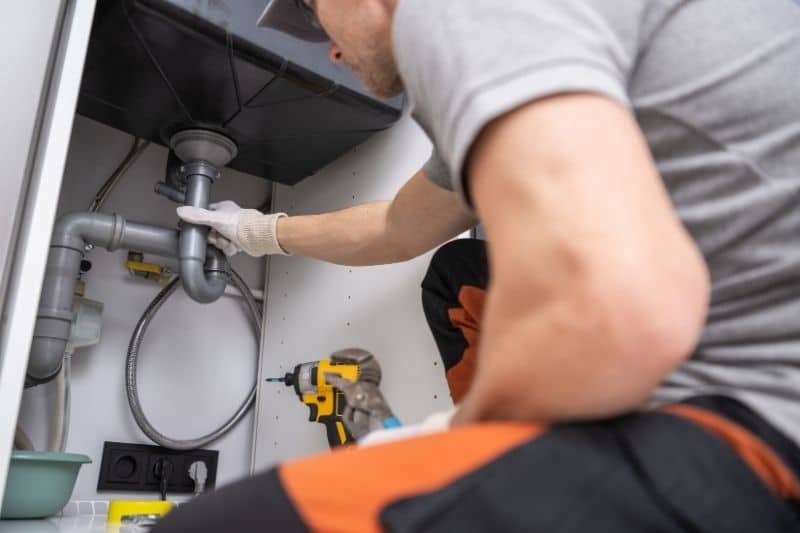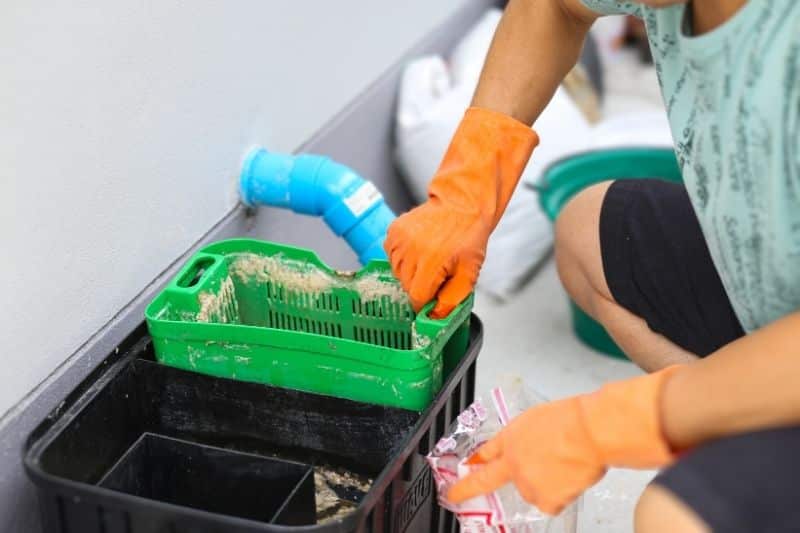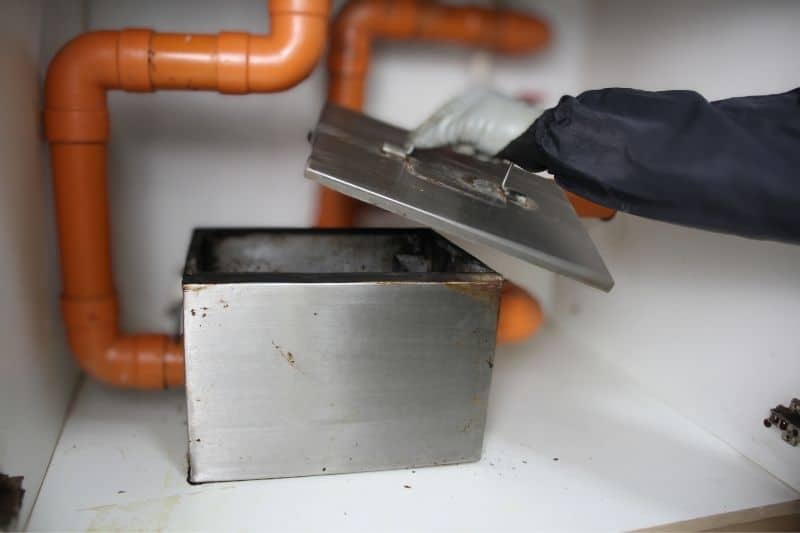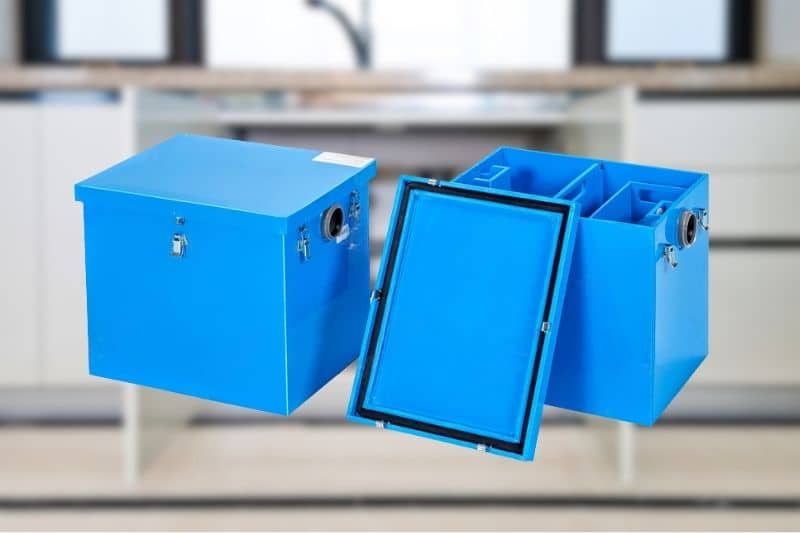Grease traps might not be the most glamorous topic, but they play a crucial role in keeping our plumbing systems and the environment clean. Imagine the chaos of a commercial kitchen without a restaurant’s grease trap: the clogged drains and pipes, foul odors, and hefty fines. Food establishments and service businesses are the main contributors to used cooking oil, fats, and grease, which can accumulate and cause blockages in drainage systems. Understanding the importance of grease traps can save you from these unpleasant scenarios and more.
What is a Grease Trap?

A grease interceptors trap, also known as a a grease trap cleaned, an a grease interceptor well, is a plumbing device designed to intercept most greases, oils and solids before they enter a wastewater disposal system.
Basic Function
Its primary function is to capture fats, oils, and grease (FOG) from kitchen wastewater, preventing large quantities of them waste from clogging pipes and sewer system and causing blockages sewer backups in municipal sewer systems.
Grease fog traps are essential in any food service operation to prevent fog and manage FOG effectively.
Components of a Grease Trap
A typical grease trap consists of one fourth of:
- Inlet and Outlet Pipes: These allow wastewater to enter and exit the trap.
- Baffles: These are barriers inside the trap that slow down the flow of wastewater, allowing grease to separate and rise to the surface.
- Collection Container: This part collects the separated grease, which can later be removed during maintenance.
How Grease Traps Work
Understanding how grease traps work can help in appreciating their importance.
The Process of Separating Grease
When kitchen wastewater flows into the grease trap, the two trap baffles slow down the water flow. This same flow slowdown allows FOG to cool and solidify. Because the grease trap itself is lighter than water, the trapped FOG floats to the down drain on top, while heavier food particles settle at the grease trap maintenance bottom.
Stages of Grease Trap Operation
- Entry: Wastewater enters the trap through the inlet pipe.
- Separation: Grease rises to the top, and solids settle at the bottom.
- Exit: The now cleaner water exits through the outlet pipe to the sewer system. The grease trap helps maintain a properly functioning drainage system by preventing FOG from entering it.
Types of Grease Traps
Not all grease traps are created equal. They come in different types to suit various needs.
- Passive Grease Traps: These are the most common and are typically found under sinks. They rely on gravity to separate grease from water and need regular manual cleaning. Regular grease trap cleaning is essential to ensure the trap functions effectively, prevent grease from reaching the traps, and comply with state regulations.
- Automatic Grease Removal Units: These advanced systems automatically skim the accumulated grease into a separate container, reducing the frequency of manual cleaning.
Benefits of Using Grease Traps

Grease traps offer several significant benefits that justify their importance.
- Environmental Impact: By preventing grease from entering the sewer system, grease traps help reduce water pollution and protect aquatic life.
- Preventing Pipe Blockages: Grease traps save you from the nightmare of clogged pipes within drainage systems, which can cause backups, overflows, and expensive plumbing repairs.
- Cost Savings: Avoiding blockages and complying with regulations can save businesses from fines and costly emergency repairs.
Grease Traps and Environmental Protection

- Reducing Water Pollution: Grease traps play a vital role in reducing water pollution by capturing harmful FOGs before they reach water treatment plants.
- Supporting Wastewater Treatment: By removing FOG, grease traps lighten the load on wastewater treatment facilities, allowing them to operate more efficiently and effectively.
Legal Requirements and Regulations

- Local and Federal Regulations: Many local and federal regulations mandate the use of grease traps in commercial kitchens. Non-compliance can result in hefty fines and business closures.
- Compliance for Businesses: Ensuring your business adheres to these regulations is not just about avoiding fines; it’s about contributing to a healthier environment and community.
Installation and Maintenance of Grease Traps

Proper Installation Guidelines
Proper installation is crucial for the effective business operation fog management of a grease trap cleaning itself. It’s best to consult with local municipality or a professional to ensure compliance with local codes and optimal business placement of grease trap cleaning itself.
Having a grease trap maintenance on sewer and drainage system, with a grease trap installed on main sewer system is essential to comply with municipal regulations and prevent plumbing issues, fines, and safety hazards.
Regular Maintenance Practices
Regular maintenance includes routine cleaning, regular grease trap cleaning, maintenance, and inspection to prevent build-ups and ensure efficient operation.
Signs Your Grease Trap Needs Maintenance

Being aware of your health risk and these signs can help you address issues before they become serious problems.
- Foul Odors: A well-maintained grease trap should not emit strong odors. If it does, it’s time for a cleaning.
- Slow Drainage: If water is draining slowly, it might indicate a clog or excessive grease build-up in the trap. Slow drainage in a restaurant’s grease trap is a clear indicator that maintenance is required.
- Grease Overflow: Overflowing grease is a clear sign that your trap needs immediate attention.
DIY Maintenance vs. Professional Services

Pros and Cons of DIY Maintenance
DIY maintenance can save money, but it requires time and knowledge. There’s also a serious health risk because of the oils, improper cleaning, and waste, leading to bigger issues and waste down the line.
Advantages of Hiring Professionals
Professionals ensure thorough cleaning, proper management solid waste and compliance with local authorities and regulations, providing peace of mind and saving time.
Common Problems with Grease Traps
Even with regular maintenance, grease traps can encounter problems.
- Clogging Issues: Excessive FOG and solid waste can clog the trap, reducing its efficiency. Grease trap work involves separating FOG to prevent clogs in the plumbing system.
- Corrosion: Over time, grease traps can corrode, especially if they are not cleaned regularly.
- Inefficiency in Grease Separation: Improperly sized or maintained traps may not effectively separate grease, leading to blockages.
Solutions to Grease Trap Problems
- Regular Cleaning: Routine cleaning is the best way to prevent most grease trap issues.
- Upgrading to Better Models: If your current trap isn’t meeting your needs, consider upgrading to a more efficient model, like an automatic grease removal unit.
Grease Trap Myths Debunked
“Grease Traps Don’t Need Regular Cleaning”
All grease traps need regular cleaning to function effectively.
“All Grease Traps Work the Same”
Different types and models of grease traps vary in efficiency normal operation and maintenance needs.
Cost of Installing and Maintaining Grease Traps

Initial Installation Costs
While installation can be costly, it’s a necessary investment for compliance and long-term savings.
Ongoing Maintenance Expenses
“Regular inspection and maintenance of sewer lines is relatively inexpensive compared to the costs of pipe repairs and fines for non-compliance.
The Importance of Grease Traps: Ensuring Efficient, Compliant, and Sustainable Kitchen Operations

Grease traps are vital for the efficient functioning of both residential and commercial kitchens. These devices play a crucial role in preventing plumbing issues by capturing fats, oils, and grease before they enter the wastewater system. By doing so, they help kitchens comply with environmental regulations and contribute to a cleaner, healthier environment. To maximize the effectiveness of grease traps, proper installation and regular maintenance of grease trap are essential. This ensures not only the longevity and importance of the grease trap installed in the plumbing and sewer system under kitchen sinks but also the overall hygiene and sustainability of the commercial kitchen and operations.
Consider professional grease trap services with Happy Housekeepers.
FAQs for Grease Trap Cleaning

- How often should a grease trap be cleaned?
- Typically, grease traps should be cleaned regularly and properly maintained once every one to three months, depending on usage and local regulations.
- Can I install a grease trap myself?
- While it’s possible, professional installation is recommended to ensure compliance and optimal functionality.
- What happens if I don’t clean my grease trap?
- Neglecting regular grease trap cleaning and maintenance can lead to clogs, foul odors, costly repairs, and non-compliance fines.
- Are there alternatives to grease traps?
- While grease traps are the most common solution, some businesses use other grease trap recovery devices or biological treatments as alternatives.
- How do I choose the right grease trap for my business?
- Consider factors like the size of your business, commercial kitchen used, volume of grease produced, and local regulations. Consulting with your business or a professional can help you make the best choice.

